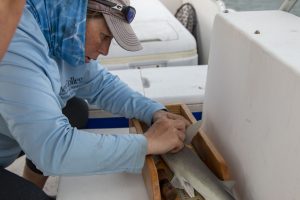
When conducting shark research in Terra Ceia Bay in October 2017, New College Associate Professor of Biology Jayne Gardiner, Ph.D. and her colleague stumbled upon an unexpected find.
It was a live female bull shark (Carcharhinus leucas), a little more than six feet in length, with brutal wounds from a harness rig. And it appeared that the shark had been used as live bait years prior.
“It’s not uncommon to see injuries like this—either from fishing gear that was attached to the sharks and they broke free, or from sharks becoming entangled in derelict or ghost gear,” said Gardiner, who was working alongside Tonya Wiley, president of Havenworth Coastal Conservation, at the time. “This situation was unique because, as we were untangling this animal, we realized that this wasn’t an accident.”
The two researchers co-authored a paper about the discovery entitled Escaped bait: bull shark Carcharhinus leucas with an intentionally attached harness rig, which was published in the peer-reviewed Journal of Fish Biology in November. Its content will likely be helpful to the recreational fishing community and regulators at the Florida Fish and Wildlife Conservation Commission (FWC), as it details just what happens to sharks when they are improperly used as live bait.
“Harness‐type live bait rigs are commonly used for small baitfish; however, some anglers use such devices with small sharks and rays when targeting larger sharks and bony fish such as Goliath grouper,” Wiley stated. “Biofouling on the apparatus and the extent of the injuries indicated the material had likely been on the shark for several years. This case highlights the dangers of using these types of devices on juveniles of long‐lived species that attain a large body size.”
Gardiner and Wiley explained that the hooks from the harness were found on the shark’s pectoral fins, implying that the harness must have been used to hold the shark in place while allowing it to swim and serve as bait for other fish.
“This practice is not necessarily illegal, but the takeaway message we’d like to share with the fishing community and regulators is: species that grow to a really large size are not a great choice for live bait, especially if you’re using gear on them that doesn’t biodegrade,” Gardiner said. “Luckily, this bull shark looked pretty good. It had all the appearances of an animal that was of healthy weight, and it was doing OK despite this horrible injury.”
The shark had grown to more than six feet by the time Gardiner and Wiley encountered it, but it was probably used for live bait when it was about half its size.
“We’re not necessarily looking to say to the fishing community not to do this, but just to say ‘Make sure it’s a legal species and size to harvest. Don’t use something that gets really big because the animal could swim around wrapped up in this gear for years,’” Gardiner said. “Or, if you’re going to use a species that does get large, use non-stainless steel hooks and leader, which will break down; don’t use plastic monofilament.”
Bull sharks are tough and resilient creatures, Gardiner said, but there is no need for them to unnecessarily suffer.
“I don’t know how often people have encountered these types of injuries with bull sharks. We’ve never caught any animal with an injury like this before, so we hope it’s a one-time thing,” Gardiner said. “I think all we’re looking to do is raise awareness that this is not an unforeseen thing. Animals break free of gear. But be mindful of the gear you’re using. Consider this as a possible outcome. We want to ultimately do this in a sustainable way.”
Gardiner has spent years educating the public and the oceanic community about similar issues. Tracking and tagging sharks in Sarasota Bay, Terra Ceia Bay and the Manatee River has been one of Gardiner’s main specialty areas, and she also studies the effects of local red tide.
In the spring of 2020, Gardiner received funding to expand one of her shark-related research projects. Mote Scientific Foundation, Inc. provided a grant for Gardiner to be the principal investigator on a project called Red Tide Recovery: Effects of Karenia brevis on Upper Trophic Level Fish Communities of Sarasota Bay. Gardiner worked on this extended research until the end of October with HCC staff and multiple New College students.
During the past summer, a collaboration with Florida International University (FIU) and HCC took the research one step further. On July 16, Scientific Reports published a paper entitled Environmental DNA detection tracks established seasonal occurrence of blacktip sharks (Carcharhinus limbatus) in a semi-enclosed subtropical bay. Starting in 2018, the researchers for this eDNA study set out to see if a spring and summer influx of blacktip sharks into Terra Ceia Bay could be detected by filtering and extracting eDNA from water samples.
Gardiner continues to focus on shark populations, and she promotes sustainable practices that benefit both the species and the local waters in which they live.
Abby Weingarten is the senior editor in the Office of Communications & Marketing.